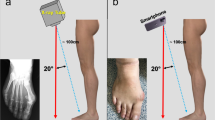Abstract
Objective
The purpose of this study was to compare the measurements made using a smartphone accelerometer and computerized measurements as a reference in a series of 32 hallux valgus patients.
Materials and methods
Two observers used an iPhone to measure the hallux valgus angle (HVA), intermetatarsal angle (IMA), and distal metatarsal articular angle (of anteroposterior foot radiographs in 32 patients with symptomatic hallux valgus on a computer screen. Digital angular measurements on the computer were set as the reference standard for analysis and comparison. The difference between computerized measurements and all iPhone measurements, and the difference between the first and second iPhone measurements for each observer were calculated. Inter- and intraobserver reliability of the smartphone measurement method was also tested.
Results
The variability of all measurements was similar for the iPhone and the computer-assisted techniques. The concordance between iPhone and computer-assisted angular measurements was excellent for the HVA, IMA, and DMAA. The maximum mean difference between the two techniques was 1.25 ± 1.02° for HVA, 0.92 ± 0.92° for IMA, and 1.10 ± 0.82° for DMAA. The interobserver reliability was excellent for HVA, IMA, and DMAA. The maximum mean difference between observers was 1.31 ± 0.89° for HVA, 0.90 ± 0.92° for IMA, and 0.78 ± 0.87° for DMAA. The intraobserver reliability was excellent for HVA, IMA, and DMAA.
Conclusions
We conclude that the Hallux Angles software for the iPhone can be used for measurement of hallux valgus angles in clinical practice and even for research purposes. It is an accurate and reproducible method.


Similar content being viewed by others
References
Perera AM, Mason L, Stephens MM. The pathogenesis of hallux valgus. J Bone Joint Surg Am. 2011;93(17):1650–61.
Coughlin MJ. Hallux valgus. J Bone Joint Surg Am. 1996;78(6):932–66.
Coughlin MJ, Jones CP. Hallux valgus: demographics, etiology, and radiographic assessment. Foot Ankle Int. 2007;28(7):759–77.
Piqué-Vidal C, Maled-García I, Arabi-Moreno J, Vila J. Radiographic angles in hallux valgus: differences between measurements made manually and with a computerized program. Foot Ankle Int. 2006;27(3):175–80.
Srivastava S, Chockalingam N, El Fakhri T. Radiographic angles in hallux valgus: comparison between manual and computer-assisted measurements. J Foot Ankle Surg. 2010;49(6):523–8.
Coughlin MJ, Saltzman CL, Nunley 2nd JA. Angular measurements in the evaluation of hallux valgus deformities: a report of the ad hoc committee of the American Orthopaedic Foot and Ankle Society on angular measurements. Foot Ankle Int. 2002;23(1):68–74.
WG Healthcare. Hallux Angles homepage. http://www.ockendon.net/halluxangles_homepage.htm. Accessed 27 February 2012.
Bussewitz BW, Levar T, Hyer CF. Modern techniques in hallux abducto valgus surgery. Clin Podiatr Med Surg. 2011;28(2):287–303.
Maffulli N, Longo UG, Marinozzi A, Denaro V. Hallux valgus: effectiveness and safety of minimally invasive surgery. A systematic review. Br Med Bull. 2011;97:149–67.
Schneider W, Knahr K. Surgery for hallux valgus. The expectations of patients and surgeons. Int Orthop. 2001;25(6):382–5.
Coughlin MJ, Freund E. Roger A. Mann Award. The reliability of angular measurements in hallux valgus deformities. Foot Ankle Int. 2001;22(5):369–79.
Resch S, Ryd L, Stenström A, Johnsson K, Reynisson K. Measuring hallux valgus: a comparison of conventional radiography and clinical parameters with regard to measurement accuracy. Foot Ankle Int. 1995;16(5):267–70.
Van Vo H, Safiedine AM, Short T, Merrill T. A comparison of 4 common methods of hand-measured techniques with a computerized technique to measure the first intermetatarsal angle. J Foot Ankle Surg. 2004;43(6):395–9.
Shima H, Okuda R, Yasuda T, Jotoku T, Kitano N, Kinoshita M. Radiographic measurements in patients with hallux valgus before and after proximal crescentic osteotomy. J Bone Joint Surg Am. 2009;91(6):1369–76.
Shaw M, Adam CJ, Izatt MT, Licina P, Askin GN. Use of the iPhone for Cobb angle measurement in scoliosis. Eur Spine J. 2012. In press.
Author information
Authors and Affiliations
Corresponding author
Rights and permissions
About this article
Cite this article
Ege, T., Kose, O., Koca, K. et al. Use of the iPhone for radiographic evaluation of hallux valgus. Skeletal Radiol 42, 269–273 (2013). https://doi.org/10.1007/s00256-012-1455-9
Received:
Revised:
Accepted:
Published:
Issue Date:
DOI: https://doi.org/10.1007/s00256-012-1455-9




